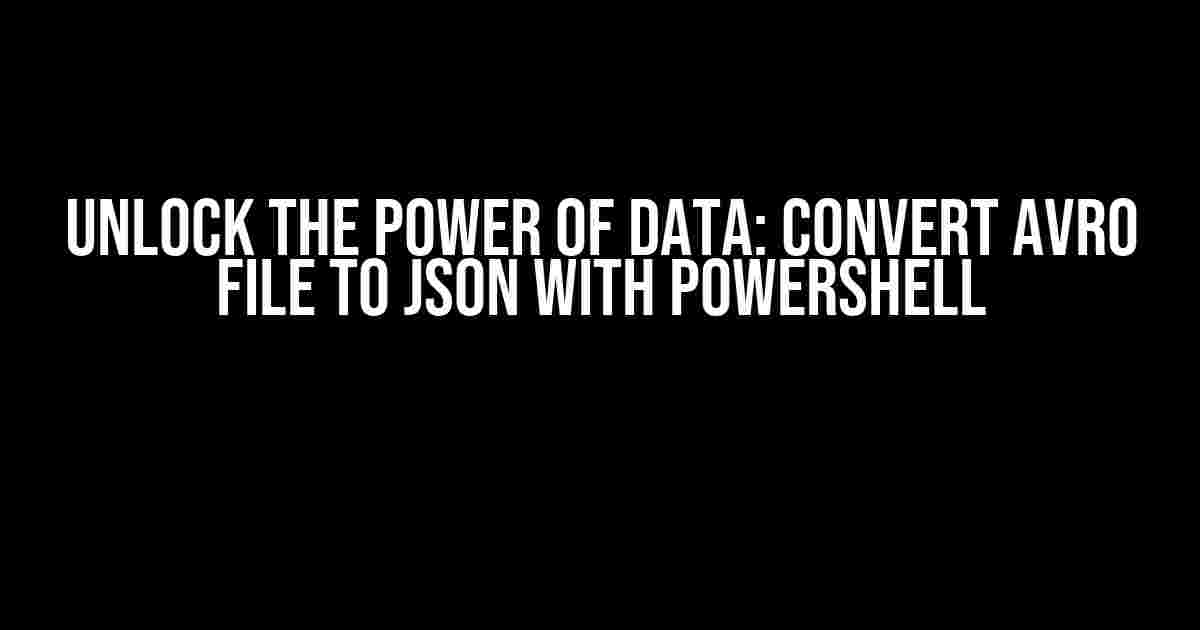Are you tired of working with clunky Avro files and wanting to tap into the versatility of JSON? Look no further! In this comprehensive guide, we’ll take you by the hand and walk you through the step-by-step process of converting Avro files to JSON using PowerShell. By the end of this article, you’ll be a pro at harnessing the power of data in no time!
What is Avro and Why Do We Need to Convert It to JSON?
Avro is a data serialization system that provides a compact, efficient, and language-agnostic way of storing and exchanging data. While Avro is excellent for data storage and transmission, it can be a challenge to work with, especially when it comes to data analysis and visualization. That’s where JSON comes in – a lightweight, human-readable data format that’s perfect for data manipulation and processing. By converting Avro files to JSON, we can unlock the full potential of our data and make it more accessible for various applications.
Why Use PowerShell for Conversion?
PowerShell is a powerful task automation and configuration management framework from Microsoft. With its robust scripting capabilities, PowerShell provides an ideal environment for executing complex data processing tasks, including Avro to JSON conversion. By leveraging PowerShell’s extensive library of cmdlets and modules, we can create a seamless and efficient conversion process that’s both easy to implement and maintain.
Prerequisites and Setup
Before we dive into the conversion process, make sure you have the following prerequisites in place:
- PowerShell 3.0 or later installed on your system
- The Avro Tools jar file (available for download from the Apache Avro website)
- A sample Avro file (we’ll use a simple example file throughout this tutorial)
Now, let’s set up our PowerShell environment:
# Set the path to the Avro Tools jar file $avroToolsJar = "C:\path\to\avro-tools-1.10.2.jar" # Add the Avro Tools jar file to the classpath Add-Type -Path $avroToolsJar
The Conversion Process: Step-by-Step
Now that we have our environment set up, let’s get started with the conversion process:
Step 1: Load the Avro File
Use the following cmdlet to load the Avro file:
# Load the Avro file
$avroFile = [io.file]::ReadAllBytes("C:\path\to\example.avro")
Step 2: Create an Avro Reader
Create an Avro reader using the loaded Avro file:
# Create an Avro reader $reader = New-Object -TypeName Apache.Avro.File.FileReader -ArgumentList @(,$avroFile)
Step 3: Read the Avro Data
Read the Avro data using the Avro reader:
# Read the Avro data
$data = @()
while ($reader.HasNext()) {
$data += $reader.Next()
}
Step 4: Convert Avro Data to JSON
Use the `ConvertTo-Json` cmdlet to convert the Avro data to JSON:
# Convert Avro data to JSON $jsonData = $data | ConvertTo-Json -Depth 100
Step 5: Save the JSON Data
Save the JSON data to a file:
# Save the JSON data to a file $jsonData | Set-Content -Path "C:\path\to\example.json" -Encoding UTF8
Pitfalls and Troubleshooting
When working with Avro files and PowerShell, you may encounter some issues. Here are some common pitfalls and troubleshooting tips:
| Error Message | Cause | Solution |
|---|---|---|
| “Could not load file or assembly ‘Apache.Avro'” | Missing or incorrect Avro Tools jar file | Verify the path to the Avro Tools jar file and ensure it’s correctly added to the classpath |
| “Unable to find type [Apache.Avro]” | Avro Tools jar file not loaded correctly | Check the Add-Type cmdlet and verify the jar file is loaded correctly |
| “Invalid JSON format” or “JSON parsing error” | Invalid or malformed Avro data | Verify the Avro file is correct and well-formed. Use tools like Avro Viewer or avro-tools to inspect the file |
Conclusion and Next Steps
Congratulations! You’ve successfully converted an Avro file to JSON using PowerShell. This is just the beginning – with JSON data, you can now unleash the full power of data analysis and visualization tools. Take your data to the next level by exploring advanced data processing techniques, data visualization, and machine learning.
Simplify your data workflows and focus on insights, not data formats. With this comprehensive guide, you’re well-equipped to tackle even the most complex data challenges.
Additional Resources
For further learning and exploration:
- Apache Avro documentation: https://avro.apache.org/docs/current/
- PowerShell documentation: https://docs.microsoft.com/en-us/powershell/
- JSON and data visualization resources: https://www.json.org/ and https://d3js.org/
Stay tuned for more data-driven adventures and tutorials!
Frequently Asked Question
Get the inside scoop on converting Avro files to JSON with PowerShell!
Q: What is the first step in converting an Avro file to JSON using PowerShell?
A: The first step is to install the Avro package for PowerShell using the command `Install-Package -Name ApacheAvro`. This package provides the necessary cmdlets to work with Avro files.
Q: How do I read an Avro file using PowerShell?
A: To read an Avro file, you can use the `Read-AvroFile` cmdlet, like this: `Read-AvroFile -Path “C:\path\to\file.avro”`. This will read the contents of the Avro file and return them as a PowerShell object.
Q: How do I convert an Avro file to JSON using PowerShell?
A: To convert an Avro file to JSON, you can pipe the output of `Read-AvroFile` to the `ConvertTo-Json` cmdlet, like this: `Read-AvroFile -Path “C:\path\to\file.avro” | ConvertTo-Json`. This will convert the Avro data to JSON format.
Q: Can I customize the JSON output when converting from Avro?
A: Yes, you can customize the JSON output by using the various parameters of the `ConvertTo-Json` cmdlet, such as `-Depth` to specify the nesting level, or `-Compress` to compress the JSON output.
Q: What if I encounter errors while converting Avro to JSON using PowerShell?
A: If you encounter errors, check the syntax of your commands, and make sure you have the correct version of the Avro package installed. You can also use the `-Verbose` parameter to get more detailed error messages. If you’re still stuck, feel free to ask for help!
